|
History of ATi Graphics cards Vol. 1
yjfy |
On August 20, 1985, Lee Ka Lau, P. H. Lau, Kwok Yuen Ho, and Benny Lau
from Hong Kong, China founded ATI as Array Technology Inc. in Canada.On
December 18, 1985, it was renamed ATI Technologies Inc.
On June 24, 2006, AMD announced the acquisition of ATi for US$5.4
billion and completed the acquisition on October 25, 2006.
In the past 21 years, ATI has dedicated many beautiful graphics cards,
even ATI cannot sort out the graphics card information. Many articles
related to the history of ATI graphics cards are too superficial, which
is not very helpful for computer hardware collectors. As a collector of
computer hardware, the author writes a history of ATI graphics cards
from the perspective of collection identification, focusing on
introducing early ATI graphics cards and engineering sample graphics
cards to create a collection guide for ATI graphics cards. In order to
fully display the ATi graphics card, this article uses many pictures
from collectors and websites. Thank you very much!
1.Graphics Solution series
At the beginning of its establishment, Working primarily in the OEM
field, ATI produced integrated graphics cards for PC manufacturers such
as IBM and Commodore.
ATI’s early graphics cards have very little information. Fortunately,
almost all of them have passed the FCC ID certification, which is an
important way to understand ATI graphics card models.
ATI's first product is Color Emulation Card. The card is equipped with
32KB DRAM memory. It was used for outputting text to a TTL
monitor via a 9-pin DE-9 connector.
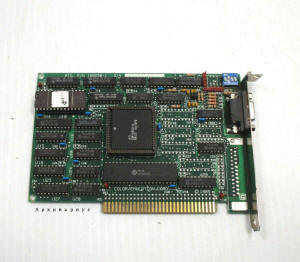
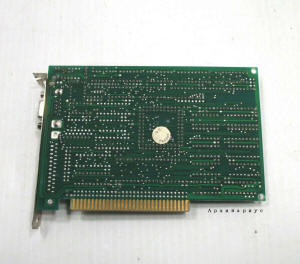
From Архивариус
Graphics Solution series graphics cards are based on Color Emulation
Card, which is the earliest ATI graphics card and the earliest ATI
graphics card that can be collected. The
main chips and components of Ati's early graphics cards were not all
developed by itself, but they were keen to put on the logo to declare
the brand.
Graphics Solution series graphics cards have four models.
1.1 Graphics Solution
Graphics Solution is based on the UM6845E CRT controller, with the use
of Central chip CW16800-A (ATI used ASIC technology to develop the first
chip in October 1985), manufactured 8-bit ISA interface graphics card.
This card uses the 64KB DRAM,supports Hercules Graphics Card mode and
extended 132x25 / 132x44 text-modes on TTL Monochrome monitors,以及All CGA
modes on both CGA/EGA and TTL Monochrome monitors。Composite output is
available on an internal 3-pin connector (no support for colors, Works
only in the 40x25 text-mode or 320x200 graphics modes)
Graphics Solution graphics cards have 3 revisions. Most of the ones that
can be seen and collected are the REV 3 version, the REV 2 version is
very rare, and the REV 1 or REV 0 version is only seen in the
promotional pictures of ATi.
1.1.1 Graphics Solution REV 1
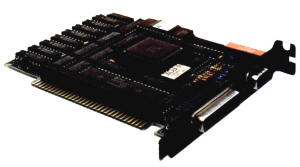
The Graphics Solution graphics card in the picture is from ATI's
official announcement picture, which is undoubtedly an engineering
sample. It may be REV 1 or even REV 0 . The display chip is Hitachi
HD460505SP-1, not UM6845 commonly used by ATI.
1.1.2 Graphics Solution REV 2
PN 168228
1.1.2.1 Engineering Sample
This is the official announcement picture of ATI. Compared with the
official product, there is only one row of jumpers in the upper right
corner.
1.1.2.2 Official product
The PCB layout of Graphics Solution graphics card REV 2 is very
different from REV 1, and there is no difference from REV 3.
1.1.3 Graphics Solution REV 3
PN 168228 FCCID:EXM5RSGSO
The figure below shows the full-interface Graphics Solution-SP.
The rare boxed Graphics Solution shows that ATI was unwilling to be
behind the scenes. The "Wonder" that appeared on the box followed the
products behind ATI. Once the "Wonder" is no longer there, ATI will
disappear.
1.2 Graphics Solution Plus
PN 168248 FCCID:EXM5RSGSO
Compared with the Graphics Solution, the Graphics Solution Plus graphics
card only updates the Central chip to CW16800-B, and there are no other
changes.
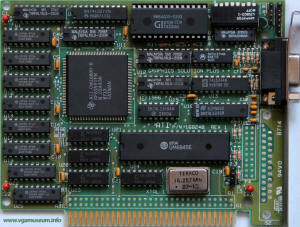
(From Vlask on vgamuseum.info)
Graphics Solution and Graphics Solution Plus graphics cards also have
variants such as Serial/Parallel.
1.3 Graphics Solution-SR
PN 168328 FCCID:EXM5RSGSSR
The "SR" of Graphics Solution-SR is "Static RAM", that is,
the Central chip is corrected to 16800-C (ATI CW16800-C) to
support 64KB SRAM.
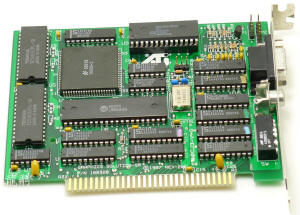
1.4 Small Wonder Graphics Solution
SMALL Wonder Graphics Solution is also known as Graphics Solution-SC.
"SC" means "single chip", which means integrating the functions of
multiple chips into the ATI 18700 chip. ATI 18700 is a graphics chip
developed in 1988. ATI did not make a strong announcement. Maybe it was
too low-end. Maybe it was overshadowed by the VGA Wonder launched in the
same year.
The SMALL Wonder Graphics Solution series has 64KB DRAM/SRAM onboard,
which seems to support expansion to 96/128KB.
SMALL Wonder Graphics Solution graphics card is equipped with ATI's
first graphics chip, which is worth collecting.
1.4.1 Graphics Solution-SC Version 1
PN 18701 FCCID:EXM5RSGSSC
64KB DRAM
Graphics Solution-SC can also be referred to as GS-SC for short.
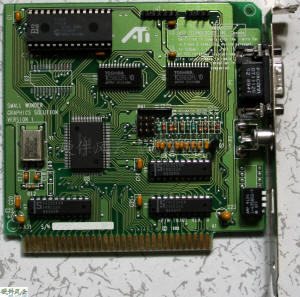
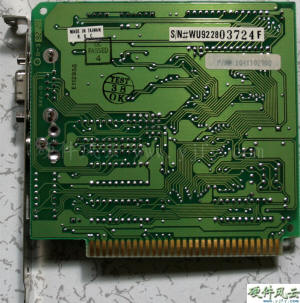
1.4.2 Graphics Solution-SC Version 2
PN 18703 FCCID:EXM5RSGSSC1
Using 64KB SRAM memory instead of DRAM.
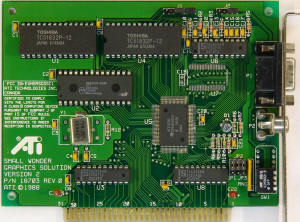
(From Palcal on vgamuseum.info)
1.4.3 Graphics Solution-SC Version 3
PN 109005100 FCCID:EXM5RSGSSC2NC
64KB SRAM

1.4.4 Graphics Solution-SC WITH GAME
PN 109003200 FCC ID:EXM 5RSGSSCGM
64KB DRAM
Equipped with a game interface.
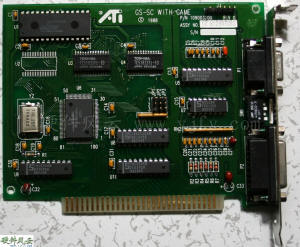
1.5 Other
Graphics Solution graphics cards were cost-effective at the time. In
addition to being cloned, Graphics Solution chips were also used.
1.5.1 Sell chip
NYSE TECHNOLOGY purchased Central chip and related graphics card design,
slightly modified to 990107-01 graphics card.
1.5.2 Clone Graphics Solution
TANDY obtained the authorization of Graphics Solution to clone and use
it directly.
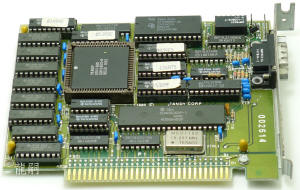 |
2. EGA Wonder series
The ATI EGA Wonder series are some of the first graphics add on products
for IBM PCs and compatibles introduced by ATI Technologies since
1986.These cards combine support for multiple graphics standards (and
disPlays) into a single card. Since these graphics cards have better
performance than IBM's display systems, they have attracted the
attention of computer manufacturers and users!
ATI uses CHIPS EGA chips in the EGA Wonder series, and ATI's first VGA
graphics card V.I.P. also uses CHIPS chips. After that, ATI also quickly
developed a VGA display chip and released the VGA Wonder series of
graphics cards. Since then, it has used its own chips to produce
graphics cards.
EGA Wonder series products have added EPROM to store settings, but they
still can’t automatically detect the type of display, and need to be
switched through the DIP Switch on the display card. EGA Wonder series
graphics cards are equipped with 256KB video memory.
2.1 EGA Wonder
FCCID:EXM5RSEGA0
Sales began shortly after passing FCCID certification on November 13,
1986.
Use CHIPS 82C431+82C432+82C433+82C434 chip, and ATI Central chip
CW16800-A. Supports CGA, Hercules mono & EGA graphics modes. 256KB DRAM,
8-bit ISA bus.
2.1.1 PN 16890
The EGA Wonder pictured below is an ATI Official announcement picture,
It is an engineering sample. Some of ATI's early engineering samples
used special PN numbers.
EGA Wonder Engineering Sample
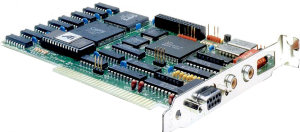
2.1.2 PN 16891
EGA Wonder Release Year 1986
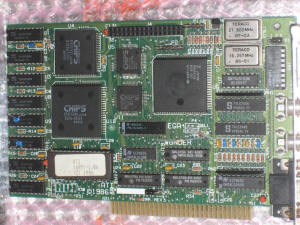
(From worthpoint.com)
2.1.3 PN 16892
EGA Wonder Release Year 1987
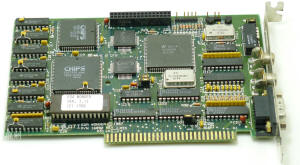
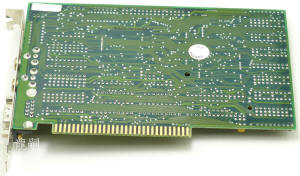
2.2 EGA Wonder 800
PN 16900 FCCID:EXM5RSEGA2
Use CHIPS P86C435 +ATI16899-0 (Clock generator chip) chip. Supports CGA,
Hercules mono & EGA graphics modes, adding 16-color VGA display mode
(800×600). 256kb DRAM, 8-bit ISA bus.
Before EGA Wonder 800, there is a model of FCCID: EXM5RSEGA1, but the
information is not detailed, it may be a transitional model, and there
are not many mass productions.
EGA Wonder 800 later Cost reduced model. Soldered DRAM. No feature
connector or composite became EGA Wonder 480.

2.3 EGA Wonder 800+
PN 109006000 FCCID:EXM5RSVGA8B1
In fact, it is the VGA Wonder graphics card that removes the VGA
function and retains the EGA function.
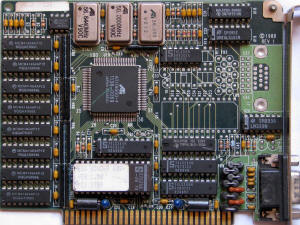
(From Vlask on vgamuseum.info)
2.4 V.I.P. (VGA Improved Performance)
PN 18008 FCCID:EXM5RSVIP1
1987-10-1 passed FCCID certification and started to sell in
early December.
This is the first VGA card from ATi. It supports for EGA/VGA
Softsense automatic mode switching (DIP switch selectable).
The actual VGA controller on this card is the Chips P82C441
supporting a max. clock of 30 MHz.9-pin TTL and 15-pin
analogue connectors.
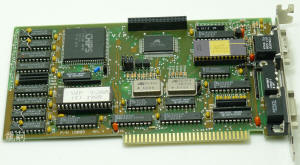
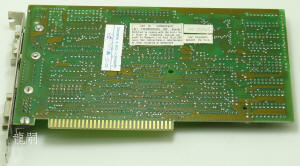
|
3. VGA Wonder series
VGA Wonder was launched in 1988. It is ATI's first-generation graphics
chip and the true core product of the VGA era. The VGA Wonder graphics
card adds an EPROM for storing settings, which can automatically detect
the display type. Later also supports SVGA display mode. There are
mainly 5 types of VGA Wonder graphics cards, with 512KB/1MB of video
memory, to cope with the 2D image display that does not require high
graphics cards. The performance of these graphics cards has been
improved compared to EGA Wonder, and ATI has become famous ever since.
3.1 VGA Wonder
Use ATI18800/18800-1 chip, 256/512KB DRAM memory.
ATI VGA Wonder Scheduled to ship in July 1988.
High-resolution drivers are the same as those included with the V.I.P.
board.Maybe ATI bought the VGA graphics technology from CHIPS.
3.1.1 VGA Wonder Engineering Sample
VGA Wonder is an 8-bit ISA interface. The official announcement picture
appeared in July 1988 and is an engineering sample.
3.1.2 VGA Wonder
PN 109006000 FCCID:EXM5RSVGA8B1
VGA Wonder is also called VGA Wonder-8, with 256KB DRAM.
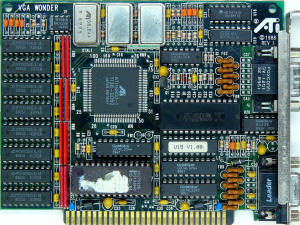
(From Palcal on vgamuseum.info)
3.1.3 VGA Wonder-16
PN 109004800 FCCID:EXM5RSVGA1
Use ATI18800/18800-1 chip with 256-512 KB video memory.
The -16 in the graphics card model indicates that it is a 16-bit ISA
bus. The early version of VGA Wonder-16 is Taofeng ATI 18800 chip, four
large crystal oscillators, and golden top RAMDAC. The picture below is
the REV 2 version, the PCB date is 8910WEEKS, and the REV 1 is a green
PCB board. The full picture and collection are not visible.
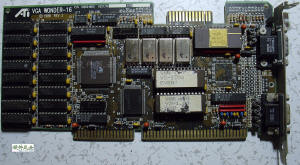
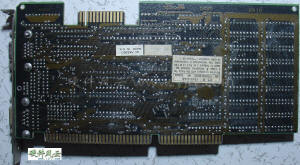
VGA Wonder-16 has many board types, including FCCID: EXM5RSVGA2,
EXM5RSVGAV4 (PN 109006300), EXM5RSVGAV5 (PN 109007200).
The OEM version of VGA Wonder-16 includes VGA 640, VGA Basic, VGA800,
VGA 1024, etc.
3.2 VGA Edge
ATI VGA Wonder Cost Reduced version is VGA Edge, there are VGA Edge-8
and VGA Edge-16. Use ATI18800-1 display chip with 256 KB video memory.
3.2.1 VGA Edge-8
The picture of VGA Edge-8 is missing. The official announcement picture
in July 1990 is actually an engineering sample picture of VGA Wonder-8.
VGA Edge-8(VGA Wonder-8 ES)
VGA Wonder-8 removes the VGA interface and related components to become
EGA Wonder 800+, presumably removing the EGA interface and related
components is VGA Edge-8.
3.2.2 VGA Edge-16
PN 109008500 FCCID:EXM1024V5
VGA Edge-16 passed the FCCID date on March 20, 1990, and the actual
retail sale was around July 1990.
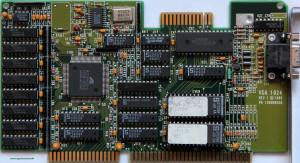
(From Vlask on vgamuseum.info)
3.3 VGA Wonder+
PN 1090009510 FCCID:EXMVGADM1
The Graphics chip ATI 28800-2, -4, or -5 256-512KB DRAM/VRAM, the chip
integration is higher, and the version is more compact.
VGA Wonder+ passed FCCID certification date is October 29, 1990, retail
date is relatively close.
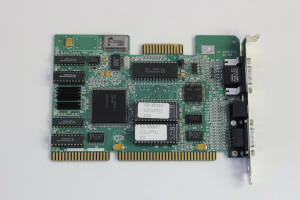
(FROM ctesales)
There are 5 sub-models of VGA Wonder+, the VRAM version of VGA Wonder+
(FCCID:EXMVGAVM1). The OEM version has VGA 640, VGA800 (FCCID:
EXMVGADM2P1), VGA 1024, VGA 1024D.
3.4 VGA Basic-16
Graphics chip ATI 28800-2, -4, or -5 256—512KB DRAM/VRAM
VGA Basic-16 is modified based on VGA Wonder+, which cancels mouse
support, reduces PCB size and uses lower frequency RAMDAC.
3.4.1 Engineering Sample
PN 109010400 FCCID:
The official announcement picture of VGA Basic-16 is an engineering
sample, the version number is REV PQ, PN is 9 digits, one digit less
than the official product, which may be the reason for the engineering
sample.
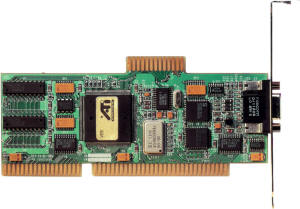
3.4.1 Official product
PN 1090010400 FCCID:
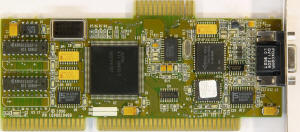
(From Palcal on vgamuseum.info)
The VGA Integra (PN 109P014210 FCCID: EXMBVGA) to be sold later uses a
PCB similar to VGA Basic-16, and the chip is ATI 28800-5.
OEM version has VGA Charger and VGA 1024D (PN 109P014400
FCCID:EXMBVGA1M).
3.5 VGA Wonder XL
PN 109P014310 FCCID:XMVGAXLV1
The FCCID passed the date 1991/7/26.
VGA Wonder XL is an enhanced version designed on the basis of VGA
Wonder+. The video memory can reach up to 1MB. The high-end RAMDAC
supports a higher refresh rate. The chip uses 28800-5 or 28800-6.
In 1992, the VGA Wonder XL24, the highest-end VGA Wonder display card
supporting 24-bit true color mode, was released.
The OEM version has VGA 1024DXL.
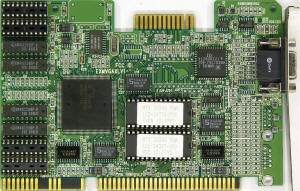
(From Palcal on vgamuseum.info)
3.6 VGA Stereo·F/X FCCID:EXMVGAFX
In 1991, VGA Stereo·F/X is a combo card that ATI integrated the
functions of VGA Wonder XL graphics card and Stereo·F/X sound card.
worth collecting. The VGAudio FX board and Audio FX board will be
shipped in the third quarter.
3.6.1 VGA Stereo·F/X
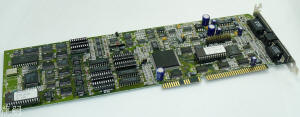
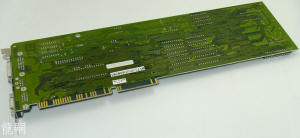
3.6.2 Stereo·F/X
ATI has produced two sound cards. In addition to the
Stereo·F/X with 8-bit ISA interface, there is also a
Stereo·F/X CD with 16-bit ISA interface.
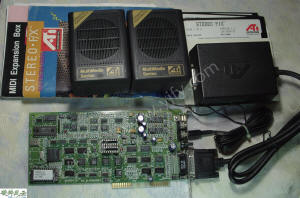
|
4. Mach8 series
In the late 1980s and early 1990s, the era of DOS operating system,
computers did not require high display technology. The graphics card at
that time was called a display adapter, and its only function was image
output, while the real graphics operations all depended on the CPU. With
the advent of the Microsoft Windows operating system, the previous
display adapters were overwhelmed. With the development of technology
and the application of various software, the demand for computer
graphics interface is getting higher and higher, and the Mach series
came into being.
The ATI Mach8 line was a series of 2D graphics accelerators for personal
computers developed by ATI Technologies.Being one of the first graphics
accelerator chips on the market, the Mach 8 did not have an integrated
VGA core. It was essentially a clone of the IBM 8514/A .
The Mach8 chip was sampled in September 1989, and the Mach8 graphics
card was finalized in November 1990, and finally sold in early 1991. It
is ATI's second-generation graphics chip.
4.1 8514/Ultra
FCCID:EXMULTRA1
Ati 38800 CHIP,1MB VRAM.
The FCCID certification passed date is January 23, 1991.
This is ATI's first 2D graphics accelerator card optimized for Windows,
but like IBM's 8514/A, it can only handle 2D graphics operations but
cannot provide VGA output.
ATi 8514/Ultra is addon accelerator with dual bus options 16-bit/16-bit
ISA and MCA。
4.1.1 PN 1090011300
The picture below is a picture of the 8514/Ultra graphics card on the
8514/Ultra graphics box. Both the graphics card and the graphics
accelerator chip are engineering samples. In this period, the two digits
after PN are 00 are engineering samples.
4.1.2 PN 1090011320
Official product
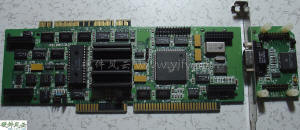
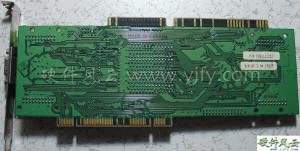
4.2 Graphics Ultra
PN 10911550 FCCID:EXMCOMBOVM1
Based on ATI 28800-6 main display chip, equipped with 512KB DRAM video
memory, ati 38800-1 graphics processing chip, equipped with 1MB VRAM
video memory.
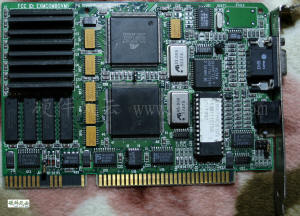
4.3 8514/Ultra AT BUS
PN 1090011710 FCCID:EXM8514VMAT1
8514/Ultra AT BUS used ATI38800 graphics processing chip, 1MB VRAM video
memory, ISA interface.
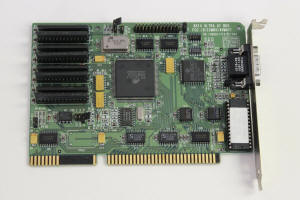
(From ctesales)
There is also a MAC interface version of 8514/Ultra MCA BUS, FCCID:
EXM8514MC. All have OEM version.
Later, there was 8514 Vantage AT dedicated to OEM, FCCID: EXMVANAT1, 1MB
DRAM video memory, ISA interface.
4.4 Graphics Vantage
PN 1090011840 FCCID:EXMCOMBODM
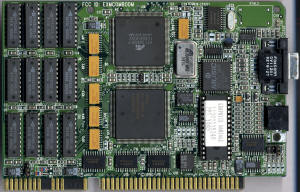
(From Pirx on vgamuseum.info)
Graphics Vantage is similar to Graphics Ultra, but it is equipped with
512KB +1MB DRAM video memory.
The Mach 8 series has not gained much commercially, and ATI even renamed
Graphics Ultra to VGA Wonder
GT tried to rely on the fame of the previous generation "VGA Wonder" to
open up sales. |
5. Mach32 series
In April 1992, ATI released the Mach 32 graphics card with integrated
graphics controller and graphics accelerator. The "32" in Mach 32 refers
to the 32-bit architecture design, and the GUI 2D graphics acceleration
capability is added for the first time. It supports ISA/EISA/VESA/MCA
interfaces. Since ATI is a participant in the VESA Local Bus
specification formulated in August 1992, the Mach 32 graphics card has
become an earlier graphics card that supports 32bit VLB interfaces.
Nov. 16-20 COMDEX Fall '92,ATI Technologies Inc. announced the first
Windows accelerator chip designed to support Intel’s PCI local bus
specification.
On April 30, 1993, after the establishment of the PCI standard led by
INTEL, ATI first developed the MACH32 graphics card with PCI interface.
The Mach 32 graphics card has graphics processing capabilities, which is
different from the previous VGA Card that simply has the display
function. The Mach 32 graphics card is a graphics accelerator card
called Graphics Card.
5.1 Graphics Ultra Pro
PN 1090018940 FCCID:EXM688VM1
1/2MB VRAM
5.1.1 ISA
Graphics chip: Mach32 (68800-3/6)
The FCCID certification was passed on August 11, 1992. In September, the
first Graphics Ultra Pro and Graphics Ultra+ with ISA interface were
released.
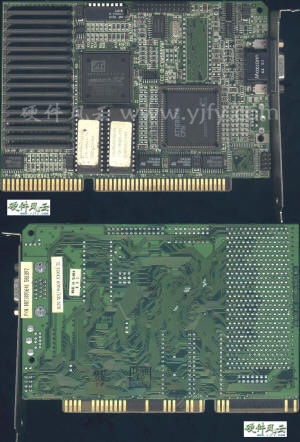
The OEM model has ISA mach32.
5.1.2 EISA
PN 109-19100-30 FCCID:EXM688VME1
Mach 32 (68800-3/6)
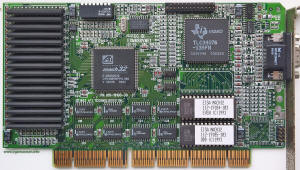
(From Pepino on vgamuseum.info)
5.1.3 MCA
Mach 32 (68800-3/6)
PN 109-19200-20 FCCID:EXM192
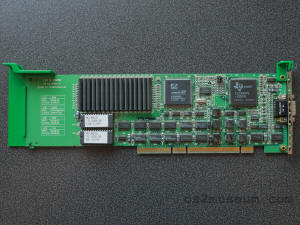
5.1.4 VESA
68800-3/6
5.1.4.1 VRAM
PN 1090019530 FCCID:EXM195
The chip of the Graphics Ultra Pro graphics card below is an early
version of Mach32 (68800-3), and the Mach32 logo has not yet been
printed. The chip date on the card is 9238 weeks, which is the release
date of the ISA version in mid-September, and the PCB date is 9242
weeks, which is mid-October. Also, the latest date of the components on
the card is 9243 weeks, and the release year on the PCB is 1992.
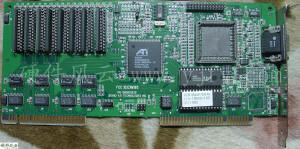
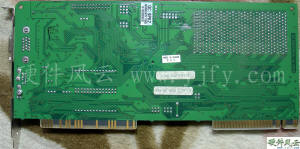
Graphics Ultra Pro's VESA interface prototype card has been evaluated in
October. Its performance is slightly higher than the ISA interface
Graphics Ultra Pro, which is much higher than the VESA interface S3
86C911 and ET4000 chip graphics cards.In November, brand computers
started using Graphics Ultra Pro with VESA interface.It can be seen that
it should be available for retail sale in November 1992. Later than the
ISA interface version.
5.1.4.2 DRAM
FCCID:EXM229
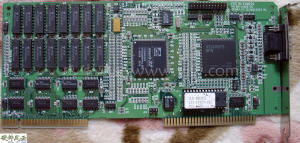
5.1.4.3 OEM
5.1.4.3.1 Graphics Ultra XLR
PN 109-19500-50 FCCID:EXM195A
PN began to be divided into three segments. The U32 of the card below is
for RAMDAC bit. I don’t know how to insert EPROM, can I still implant
OEM information?
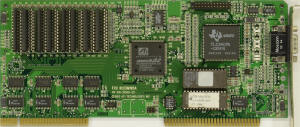
(From Palcal on vgamuseum.info)
5.1.4.3.2 VLB Mach32-D
PN 1090019630 FCCID:EXM196
There are also VLB mach32-D 1MBDRAM, Graphics Ultra CLX VLB 2MBDRAM.
VLB mach32-D
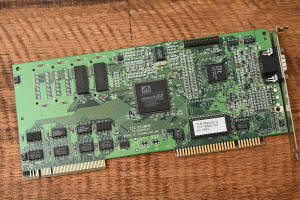
(From dependency-injection.com)
5.1.5 PCI
Chip: 68800 AX, 1/2 RAM
The Mach32 PCI interface version of the chip is 68800 AX, and the
68800-3/6 chip cannot be used directly. The 68800 AX redesign took more
than a year. The first to be launched is Graphics Ultra Pro with VRAM
memory version.
5.1.5.1 VRAM
5.1.5.1.1 Engineering Sample
PN 109-23000-00C FCCID:
The FCCID certification was passed on October 19, 1993 (9343 weeks). The
PCB date of this engineering sample graphics card is 9332 weeks, and the
display chip is PROTOTYPE.
I quoted a lot of engineering sample graphics card pictures above, which
are just pictures.
This engineering sample graphics card picture is a real picture. It is
the earliest engineering sample graphics card known in the collection of
computer hardware collectors. It is also the earliest PCI graphics card.
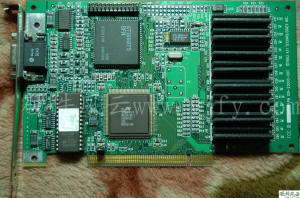
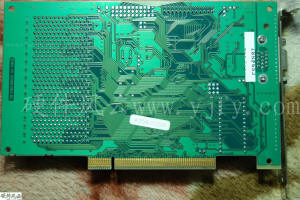
5.1.5.1.2 Official product
PN 109-23000-10 FCCID:EXM230A
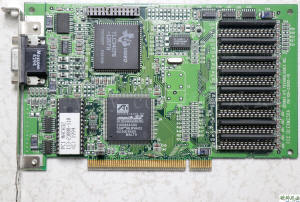
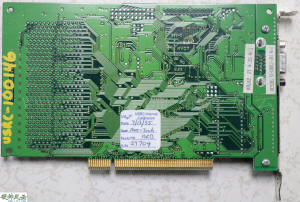
5.2 Graphics Ultra+
PN 1090019340 FCCID:EXM688DM1
ATI 68800-3/6,ISA, 1/2MB DRAM
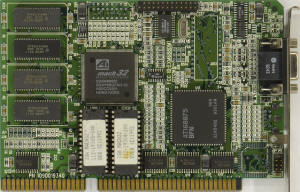
(From Palcal on vgamuseum.info)
The time for FCCID certification is August 18, 1992.
OEM model has ISA mach32
5.3 Graphics Wonder
1MB DRAM
5.3.1 ISA
5.3.1.1 Engineering Sample
PN 109-22801-00B FCCID:EXM228M
The official announcement picture is an engineering sample, and “B” is
added at the end of the third paragraph of PN, and “00B” is the label of
the engineering sample.
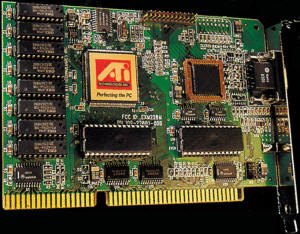
5.3.1.1 Official product
PN 109-22800-10 FCCID:EXM228
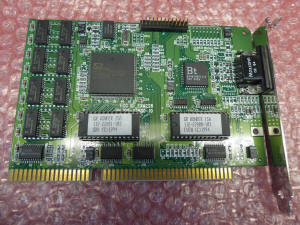
(From echelonii )
5.3.2 VESA
PN 109-23400-00 FCCID:EXM234
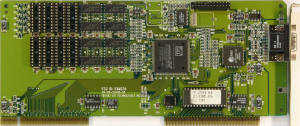
(From Palcal on vgamuseum.info)
Graphics Ultra Pro (FCCID: EXM229) was later partly called Graphics
Wonder.
OEM Version of VGA 1024 VLB. It is based on Mach32, but it is placed in
the VGAWonder series. |
6. Mach64 series
The further development of graphics technology makes personal computers
enter the multimedia era from graphics. In 1994, ATI released the Mach64
chip, which is ATI's fourth-generation graphics chip. It has created
many famous firsts. It was the world's first chip to support color
conversion from YUV to RGB at that time, and it was a milestone for
personal computers to provide video acceleration. It became the first
graphics card adapter to be used on PC and Mac computers in the form of
Xclaim, and provides full-motion video playback acceleration like S3's
Trio.
6.1 Graphics Pro Turbo
Mach64 GX,2/4 MB VRAM
Graphics Pro Turbo graphics card was first released, its PCI and VESA
Local Bus Versions ship in April 1994; an ISA Version ship in May.
6.1.1 PCI
PN 109-25500-20 FCC ID:EXM255
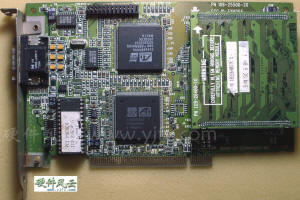
Graphics memory daughter card
PN 109-26400-0
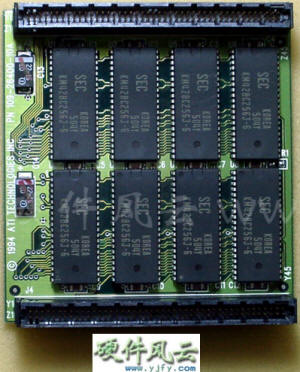
There are Graphics Pro Turbo 1600, 4MB VRAM, 220Mhz RAMDAC (IBM
37RGB514), Video Card Maximum resolution: 1600 X 1200 non-interlaced.
6.1.2 VESA
PN 109-26900-30 FCC ID:EXM269
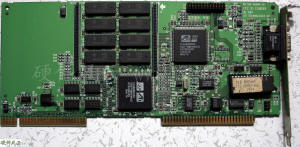
6.1.3 ISA
PN 109-28100-00 FCC ID:EXM281
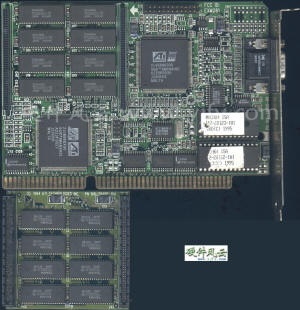
6.2 Xclaim GA
Xclaim GA is ATI's first graphics card to support Mac computer systems.
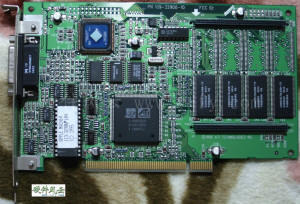
6.2.1 Apple monitor port
PN 109-32900-10 FCC ID:EXM329
6.2.2 Apple+VGA monitor port
PN 109-33200-10 FCC ID:EXM332
4MB VRAM ,220Mhz RAMDAC(IBM 37RGB514)。
6.3 Win Turbo
Mach64 GX2 MB VRAM
Similar to GRAPHICS Pro Turbo, without the memory upgrade board, non-upgradable
to 4MB video memory, or only 2MB video memory. There are PCI, VESA, ISA
interface versions.
There are also specially designed Win Turbo graphics cards, such as:
PN 109-23600-10 FCC ID:EXM236
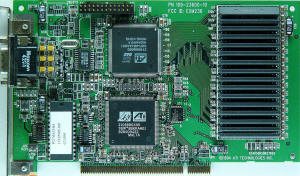
(From Palcal on vgamuseum.info)
OEM products have PCI and VESA interface versions.
6.4 Graphics Xpression
1/2 MB DRAM
On sale in June 1994
6.4.1 PCI
6.4.1.1 Mach64 GX
PN 109-25400-43 FCC ID:EXM254A
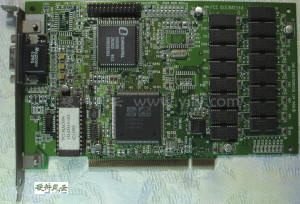
6.4.1.2 Mach64 CX
PN 109-30200-10 FCC ID: EXM254A (It should be EXM302, it may not pass.)
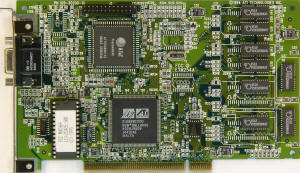
(From Palcal on vgamuseum.info)
6.4.2 VESA
Mach64 GX1/2 MB
PN 109-30300-00 FCC ID: EXM301 (also a bit messy here)
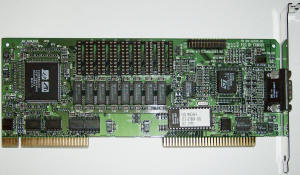
(From hattix.co.uk)
6.4.3 ISA
Mach64 GX1/2 MB DRAM
PN 109-19300-10 FCC ID:EXM193
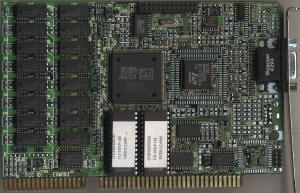
(From Pirx on vgamuseum.info)
6.5 Win Boost
Mach64 GX1/2 MB DRAM
Mach64 CT1/2 MB DRAM
More distinctive is the PCI interface graphics card with Mach64 CT
chip(Cost-reduced Mach64 with integrated RAMDAC and clock chip) and 1/2
MB display memory:
PN 109-33100-10 FCC ID:EXM331
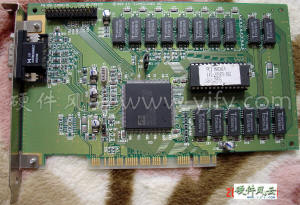
6.6 Win Charger
Mach64 CT1/2 MB DRAM
PN 109-32100-20 FCC ID:EXM321
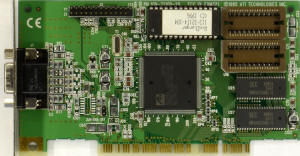
(From Palcal on vgamuseum.info)
6.7 Video Xpression
Mach64 VT/VT2,1/2 MB DRAM,PCI
PN 109-34000-00 FCC ID:EXM340
On sale around April 1996.
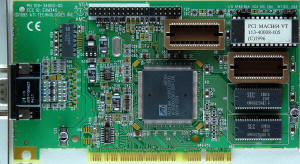
(From Palcal on vgamuseum.info)
OEM products include Video Boost.
6.8 Video Xpression+
Mach64 VT4,2MB SDRAM,PCI
December 2, 1996 ATI Technologies Inc. has introduced the VIDEO
XPRESSION+, providing superior TV-quality video and 2D graphics
acceleration.
PN 109-40900-10 FCC ID:EXM409
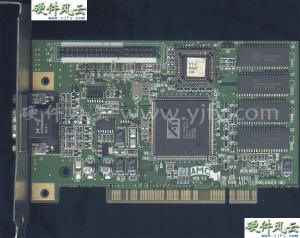
6.9 Video-It!& Video Basic
ATI’s 68890 PC TV decoder chip was announced in mid-November 1993. The
68890 chip was first used on the Video-It! card. Video-It! was launched
in June 1994. With the help of the onboard Intel i750PD VCP (Video
Compression Processor), the chip can capture video at 320x240 @ 15 fps
or 160x120 @ 30 fps, and can compress/decompress in real time. "Video
Basic" without onboard Intel i750PD chip can only capture video at
320x240 @ 10 fps or 160x120 @ 24 fps.
PN 109-28500-00 FCC ID:EXM285
Video-It!
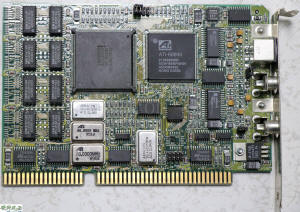
6.10 ATI TV
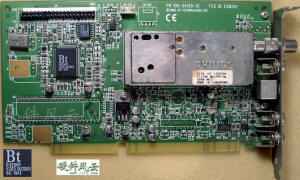
October 28, 1996 ATI Technologies Inc. announced that its multi-function
"smart" ATI-TV tuner card is now shipping. ATI-TV is the most
feature-rich TV tuner card Enable Windows Internet TV, zoom in, capture
videos from TV shows or camcorders, watch PC video clips, and still
enjoy fast graphics processing.
PN 109-34100-10 FCC ID:EXM341 |
7. Rage 3D series
In the mid-1990s, the development of graphics technology reached a new
peak. Traditional 2D display technology has long been unable to meet the
demand, especially in the game field. The embryonic form of 3D has
emerged. Many graphics manufacturers have launched the first generation
of 3D graphics cards, such as NVIDIA's NV1, Matrox's Mlennium and
Mystique, PowerVR's PCX1, S3's Virge3D and so on. ATI also launched the
first-generation 3D graphics chip 3D Rage to enter the 3D battlefield.
3D Rage is ATI's fifth-generation graphics chip. The 2D core inherits
from Mach64 and adds 3D processing functions. It has a rendering
pipeline and a TMU; the process is 0.5 microns, equipped with 2MB DRAM
memory, and supports MPGE-1 hardware acceleration , Is ATI's
fifth-generation graphics chip. However, although it provides 3D
acceleration features such as light source processing, it does not
support hardware Z-buffer, so it is not a true 3D chip.
3D RageAnnounced date is 13th of November 1995, Release Date is March
31, 1996. The actual release date may be a bit later, after all, its
product advertisement was only launched in August 1996.
7.1 3D Xpression
PN 109-34000-00 FCC ID:EXM340
In the era of Rage, ATi rarely passes FCC ID certification, and every
type of graphics card does not have FCCID, but the information is
abundant, and the identification of graphics cards is not difficult.
The graphics card that uses the 3D Rage chip only has 3D Xpression,
which is particularly common because it directly uses the PCB board of
Video Xpression. As a result, there is no picture of the graphics card
in the ATI advertisement, only the words "RAGE 3D" are highlighted.
3D Xpression
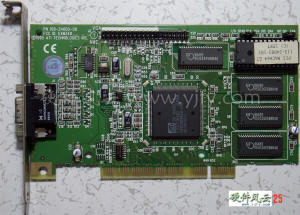
7.2 Sell chip
Entering the 3D era, ATI is still OEM and selling chips. The 3D Rage
display chip is used by PASTEL on the TGS-5700 TV card, which really
proves that the 3D performance of 3D Rage is really not surprising. Of
course, it also pointed a way to ATI-All In Wonder.
PASTEL TGS-5700
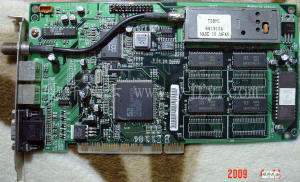
8. Rage II series
3D Rage quickly faded out of the market due to compatibility issues. Six
months later, on September 5, 1996, ATI released a new and improved 3D
Rage II. 3D Rage II is the first 3D chip in the true sense. 3D RAGE II
has corrected the compatibility problem of 3D RAGE. The 2D aspect uses
the redesigned MACH 64 GUI engine, and the 2D performance is increased
by 20%. 3D Rage II supports bilinear, trilinear filtering, Z-buffer and
some Direct3D material blending modes, but the pixel filtering is only
slightly better than S3's ViRGE, which can only be regarded as quite
satisfactory compared to other products at the time. The video memory is
matched with a single-cycle EDO of 2 to 4 MB or a high-speed SGRAM. The
3D RAGE II chip is compatible with 3D RAGE feet. In addition, MPEG-2
(DVD) playback function has been added. This chip also supports
Direct3D, OpenGL and other drivers. The driver also supports Windows 95,
Windows NT, Mac OS and OS/2 operating systems. ATI also equips RAGE II
with ImpacTV TV encoding chip.
Rage II series chips include Rage II, Rage II+DVD, and Rage LT.
8.1 3D Xpression+ PC2TV
Rage II/Rage II+DVD,2/4 MB SDRAM
September 13, 1996 - ATI Technologies Inc.launched the first graphics
accelerator board to offer both powerful 3D acceleration and a TV out
capability -- the 3D XPRESSION+ PC2TV.
Providing the highest quality 3D rendering and fast 2D acceleration ,
the 3D XPRESSION+ PC2TV features ATI's ImpacTV which allows output
directly to a TV screen, even a large-screen TV.
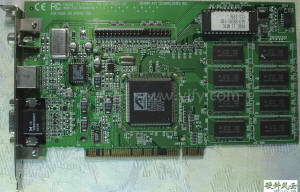
8.2 3D Xpression+
PN 109-38500-00 FCC ID:EXM385
3D Xpression+ is 3D Xpression+ PC2TV that cancels the video output of
ImpacTV.
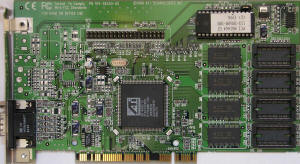
(From Vlask on vgamuseum.info)
8.3 3D Pro Turbo PC2TV
Rage II/Rage II+DVD,2/4 SGRAM
September 18, 1996,ATI Technologies Inc., announced the 3D Pro Turbo
PC2TV.
3D Pro Turbo PC2TV equipped with ImpacTV video output.
8.3.1 Early
PN 109-40700-00
The early 3D Pro Turbo PC2TV used EPROM.
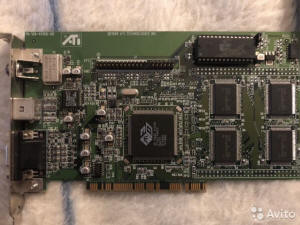
8.3.2 Late
PN 109-37900-00
The later 3D Pro Turbo PC2TV uses EEPROM.
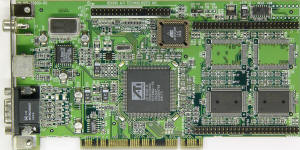
(From Palcal on vgamuseum.info)
8.4 3D Pro Turbo
Rage II/Rage II+DVD,2/4MB SGRAM
3D Pro Turbo is 3D Pro Turbo PC2TV that cancels the video output of
ImpacTV.
The castrated Version of Xclaim 3D is also 3D Pro Turbo.
PN 109-38200-00 FCC ID:EXM382
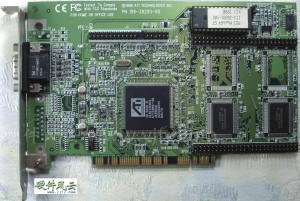
PN 109-34600-10
2MB SGRAM Graphics memory daughter card
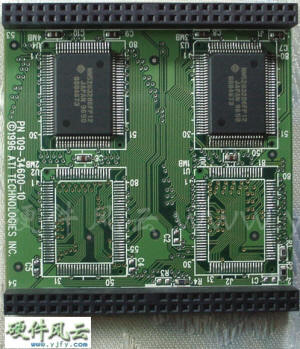
8.5 Xclaim 3D
Rage II/Rage II+DVD,4/8MB SGRAM
PN 109-39200-00
August 7, 1996 - ATI Technologies Inc announced the Xclaim 3D graphics
accelerator。
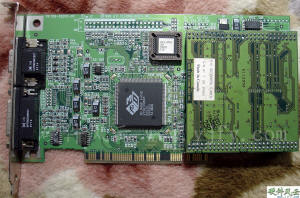
PN 109-38000-00
4MB SGRAM
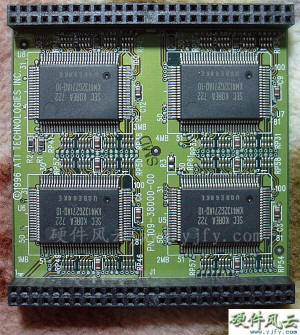
8.6 Xclaim VR
Rage II/Rage II+DVD,4/8MB SGRAM
PN 109-37100-00
August 7, 1996 - ATI Technologies Inc. announced Xclaim VR, a 3D
graphics and multimedia accelerator that brings arcade-quality, big
screen TV gaming plus a full suite of multimedia features to PCI enabled
Macintosh systems.
Xclaim TV, which was launched on the same day, the external TV tuner
that brings the world of broadcast TV to the Mac desk top. For use with
ATI's Xclaim VR, the 3D and multimedia accelerator.
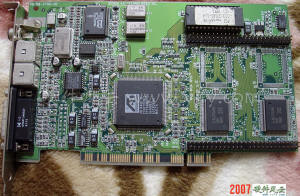
8.7 All In Wonder
Rage II/Rage II+DVD,2/4MB SDRAM
PN 109-38600-00
November 11, 1996 ATI Technologies Inc. announced the
All-In-Wonder 3D accelerator and multimedia board for
Pentium PCs that provides no fewer than seven of the most
sought-after features by gamers and multimedia enthusiasts -
(1) fast 3D acceleration, (2) 64-bit 2D performance, (3)
TV-quality video acceleration, (4) still and motion video
capture, (5) advanced TV tuner capabilities, (6)
flicker-free TV-out for big screen viewing and (7) stereo TV
audio for high quality stereo sound.
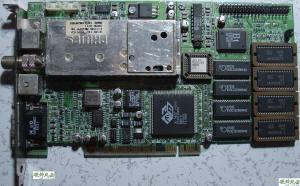
8.8 TV Wonder
TV Wonder
PN 109-56700-11
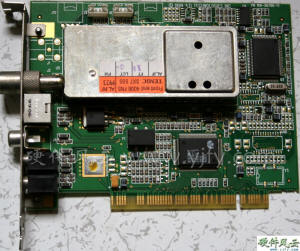
|
9. 3D Rage Pro series
September 18, 1996。ATI Technologies Inc., announced the 3D PRO, the
newest member of its high-performance 3D, 2D and video accelerator
family.
The 3D Rage Pro chip has a new triangle setting engine, and the
perspective correction algorithm has also been improved. At the same
time, distance blur and transparency effects have been enhanced;
reflective highlight effects and enhanced video playback functions have
also been added, especially DVD playback. The 3D Rage Pro chip supports
AGP 2X, making MPEG-2 acceleration performance even further. 3D Rage Pro
supports up to 8MB SGRAM or 16MB WRAM.
9.1 Xpert@ Play
May 19, 1997 ATI Technologies Inc announced the Xpert@Play , the
graphics accelerator add-in board that will set new standards for
gaming, multimedia and mainstream graphics acceleration applications.
Xpert@Play provides 3D, 2D and DVD video acceleration and connects to a
large screen TV, monitor or VCR.
Xpert@ Play that cancels the video output of ImpacTV2 is Xpert@ Work.
The following takes the PCI interface as an example to introduce Xpert@Play
graphics card.
9.1.1 Engineering Sample?
PN 109-41900-00A
The PN 109-41900-00A of this card, 00A of which looks like an
engineering sample, is actually an early product, which is an error in
the production process.
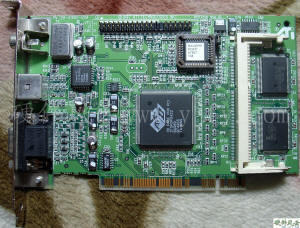
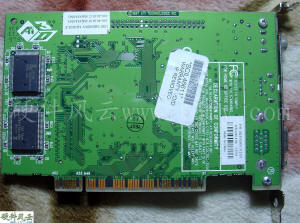
9.1.2 Official product
PN 109-41900-00
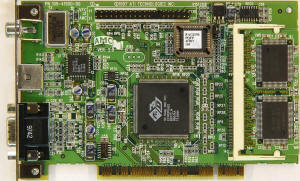
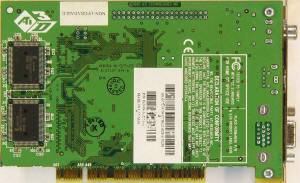
(From Palcal on vgamuseum.info)
9.2 Xpert@ Work
May 26, 1997 ATI Technologies Inc. announced the Xpert@Work, the
graphics accelerator that sets the new standard for Windows NT and
Windows 95 performance and productivity. With superior 2D, 3D and video
acceleration.
The Xpert@Work Based on ATI's new 3D RAGE PRO component, a powerful
230MHz DAC and up to 8MB memory, the Xpert@Work offers flicker-free 85Hz
refresh rates at 1600x1200.
The following takes the AGP interface as an example to show the Xpert@Work
graphics card, which also reproduces the development process of the ATI
graphics card more completely.
9.2.1 Engineering Sample
PN 109-40200-00B
Xpert@Work Engineering Sample
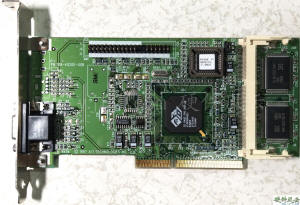
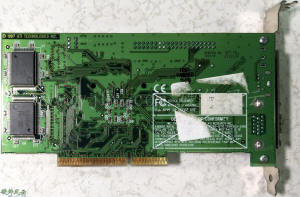
9.2.2 Qualification Sample
PN 109-40200-00
Xpert@Work Qualification Sample
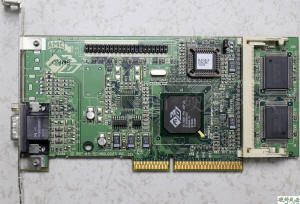
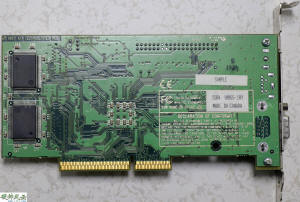
9.2.3 Official product
PN 109-40200-20
Xpert@Work
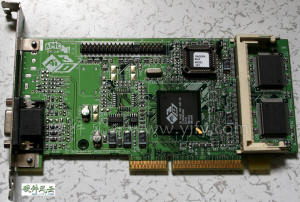
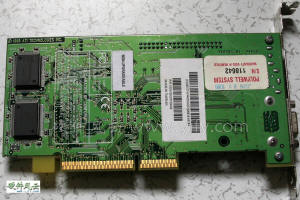
9.3 Xpert 98
Rage Pro Turbo
Xpert 98 is the ultimate gaming experience in Windows 98.
Some Xpert 98 graphics cards are Xpert@Play /Xpert@Work graphics cards
that cancel the video memory expansion slot.
9.3.1 PCI
PCI, PQFP
PN 109-41900-10
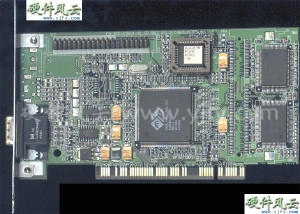
9.3.2 AGP
PN 109-49800-10
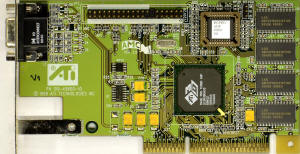
(From Palcal on vgamuseum.info)
9.4 Xclaim 3D Pro
PN 109-42900-00
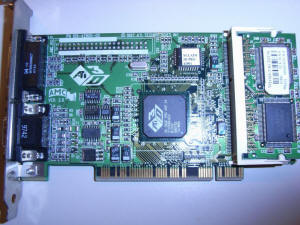
(From zigsow.jp)
9.5 Xclaim VR Pro
PN 109-43100-00
Graphics memory daughter card
PN 109-42000-00
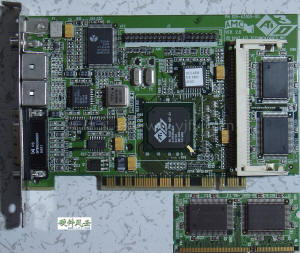
9.6 Nexus GA
July 28, 1997 ATI announces Nexus GA for Apple computers.
NEXUS GA has 8/16MB WRAM, is a high-performance 2D and 3D graphics board
developed with the professional graphics designer in mind. can
noticeably improve the graphics disPlay capabilities. Featuring leading
2D performance, including true color at highest resolutions, plus 3D
functionality.
PN 109-42600-00
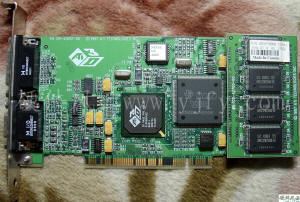
PN 109-42700-00
Graphics memory daughter card
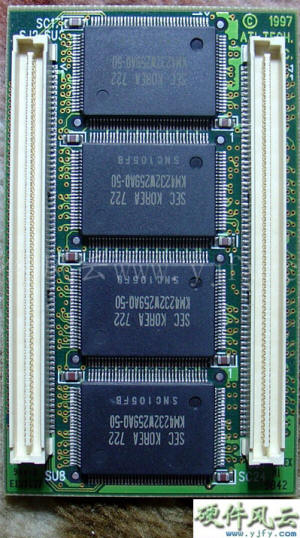
9.7 3D Charger
ATI's 3D CHARGER graphics board provides low cost solutions for OEMs and
System Integrators (this is not a retail product).
The chips are 3D Rage Pro PCI, 3D Rage II + DVD, these two chips can be
used in the same board, PCI interface. There is also RAGE IIC chip.
9.7.1 3D Rage II+ DVD
PN 109-38800-00
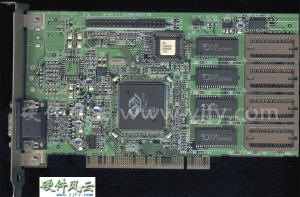
9.7.2 3D Rage Pro
PN 109-40600-00
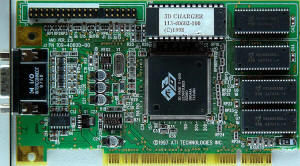
(From Palcal on vgamuseum.info)
9.7.3 Rage IIC
January 12, 1998
ATI Technologies Inc. announced the RAGE IIC AGP graphics accelerator, a
low-cost 2D, 3D and video chip, ideal for cost-sensitive AGP corporate
systems. RAGE IIC AGP is pin-compatible with ATIís performance-leading
and market-leading RAGE PRO components
9.7.3 1 AGP
PN 109-48300-00
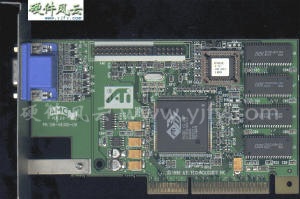
9.7.3.2 PCI
PN 109-40600-10
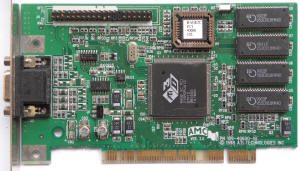
(From Zaatharen on vgamuseum.info)
9.8 Xpert LCD
3D RAGE LT PRO,4/8 MB SGRAM
PN 109-47200-00
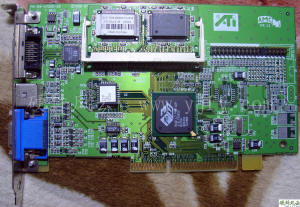
9.9 XCLAIM 3D PLUS
3D RAGE LT PRO,8 MB SDRAM
Xclaim 3D PLUS features all the powerful 2D and 3D graphics acceleration
of Xclaim 3D, plus, it is the first to bring the cutting edge Digital
Flat Panel (DFP) disPlays to PCI Mac.
9.9.1 Engineering Sample
PN 109-54100-00A
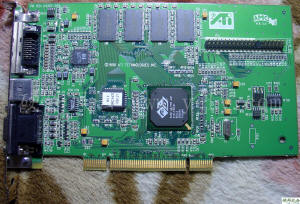
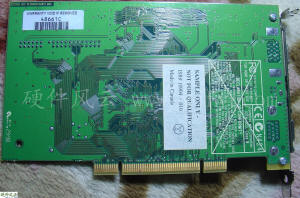
9.9.2 Official product
PN 109-54100-00
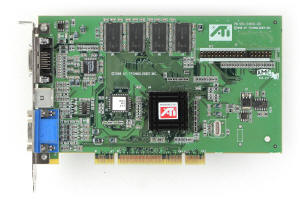
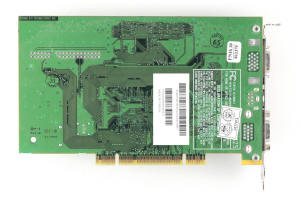
(From vgamuseum.ru)
9.10 Xpert XL
January 11, 1999 ATI Technologies Inc.announced the RAGE XL and RAGE XC
general purpose graphic accelerator chips. The two new .25 micron
graphics chips,full AGP (Accelerated Graphics Port) 2X acceleration.
The RAGE XL is the world's first volume graphics chip . RAGE XL support
for TFT panels extends to 1280x1024 resolution, and use of Ratiometric
expansion technology ensures that images can be scaled to any screen
size.
The RAGE XL and RAGE XC are software compatible with all RAGE PRO
designs, and pin compatible with RAGE 128 chip.
PN 109-66700-01
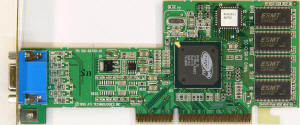
(From Palcal on vgamuseum.info)
9.11 All In Wonder Pro
PN 109-44600-30
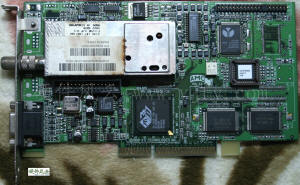 |
10. Rage 128 series
In 1998, the battle for 3D graphics cards intensified this year. At this
time, NVIDIA, 3DFX, MATROX, S3 and other manufacturers have launched a
series of excellent products. ATI’s Rage 128 competitors are VOODOO 2
and TNT. ATI’s goal is to surpass the latter two in terms of
performance. At that time, ATI seemed to have done it, especially in
terms of image quality.
Rage 128 Release Date August 1st, 1998, is ATI's first 128bit 3D chip,
supporting AGP 4X interface and hardware MPEG-2 acceleration. One of the
major selling points of this product is that it is specifically designed
for 32bit colors. The performance drop from 16bit color to 32bit color
is less than 5%, which was quite amazing at the time. In terms of
performance, the RAGE 128 launched by ATI was not the top at the time,
but the RAGE 128 wins in all performance indicators are very average.
Not only does it still have an advantage in DVD dynamic interpolation
compensation, it also supports VIVO and ALL-IN-Wonder graphics card
versions, which are very powerful multimedia graphics cards. Rage 128 is
also divided into high and low models Rage 128 GL and Rage 128 VR
(64bit) to face different user groups.
10.1 Rage Fury
It was first released in November 1998 and went on sale around the
beginning of 1999.
Up to 32MB frame buffer for realistic 3D gamePlay with massive textures
and high resolutions Powered by ATI RAGE 128 GL, a true 128-bit graphics
engine 32-bit true color 3D acceleration (16.7 million colors) and up to
1920x1200 without significant drop in game frame rates.
10.1.1 Engineering Sample
PN 109-51900-00A
The official announcement picture of Rage Fury is an engineering sample.
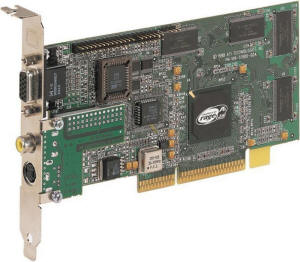
10.1.2 Official product
PN 109-51900-01
Entering the era of Rage 128, with the improvement of performance, the
chip generates a lot of heat and begins to use heat sink.
10.2 Xpert 128
PN 109-51800-01
Rage 128 GL 16MB
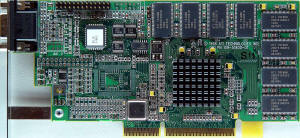
(From Palcal on vgamuseum.info)
10.3 Xpert 2000
PN 109-66500-00
Rage 128 VR 64-bit 32MB
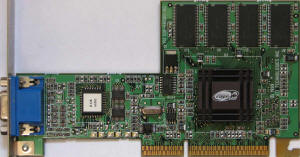
(From Vlask on vgamuseum.info)
10.4 Rage Magnum
PN
109-50500-00/109-51900-00
ATI RAGE 128 GL 32MB SGRAM/SDRAM

(From Palcal on vgamuseum.info)
10.5 Xpert 99
PN 109-52000-01
The value-packed 8MB 3D, 2D and DVD video accelerator
RAGE 128 VR
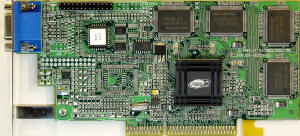
(From Vlask on vgamuseum.info)
10.6 XCLAIM VR 128
PN 109-57400-00
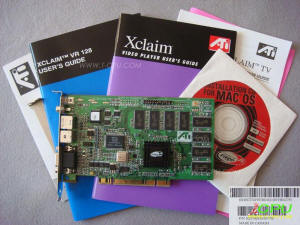
10.7 Rage Orion
RAGE ORION uses RAGE 128 GLchip, 16 MB graphics memory.
PN 109-57400-00
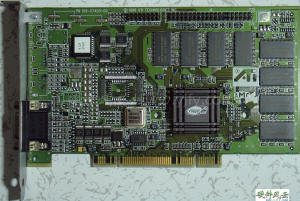
10.8 NEXUS 128
NEXUS 128 is a powerful, 128-bit graphics force in the studio. This
ultra-fast graphics accelerator board supports ultra-high resolutions of
1920x1200 in both 2D and 3D.
True color (32-bit) Workstation graphics
128-bit 2D/3D acceleration
32MB of powerful graphics memory
Ultra-high resolution support up to 1920x1200
PN 109-57500-00A
NEXUS 128 Official announcement picture(Engineering Sample)
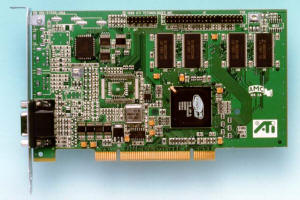
10.9 All In Wonder 128
October 14, 1999 ATI announces the 32MB All-in-Wonder 128, the most
versatile combination TV, video and graphics board on the
market.Features advanced dbx stereo TV tuner, Digital VCR, Video
Capture, Real-time video compression and DTV readiness.
PN 109-53400-11
|
11. Rage 128 Pro series
In 1999, NVIDIA gradually emerged as a king in the 3D
graphics card battle, and it has the potential to succeed
the former king of 3DFX. At that time, NVIDIA was the first
to launch the revolutionary GeForce 256. Although ATI's Rage
128 Pro was excellent, it could not compete with the
powerful and advanced GeForce 256. Later, ATI adopted Dual
ASIC dual-chip technology to launch the "Aurora project"
April 6, 1999 ATI Technologies Inc. announced the
performance-enhanced RAGE 128 PRO AGP 4X chips: the best of
class RAGE 128 PRO GL for entry level Workstation and high
end PC markets and the cost effective RAGE 128 PRO VR for
mainstream commercial and consumer markets.First chip in the
world to integrate a DVI-compliant TMDS transmitter
11.1 Rage Fury Pro
August 5, 1999 ATI Technologies Inc. announced the 32MB RAGE
FURY PRO. The RAGE FURY PRO offers performance up to 50 per
cent faster in 3D Winbench performance and up to 40 per cent
faster frame rates in Quake III at 1,024 x 768 in 32-bit
than the previous RAGE FURY.
The RAGE FURY PRO's 32MB of memory can handle even the most
texture-laden games and its 32-bit true color capability is
ideal for performance gaming and high end 3D and video
applications.
Ready for the next generation of AGP 4X systems, the RAGE
FURY PRO provides full AGP 4X support.
11.1.1 SDRAM
11.1.1.1 Engineering Sample
PN 109-63200-00B
RAGE FURY PRO first introduced a version of SDRAM video
memory that supports VIVO. Later there was a DVI output
version.
(From anandtech.com)
11.1.1.2 Official product
PN 109-63200-01
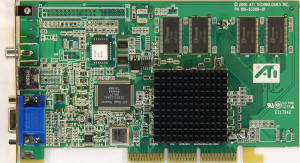 (From Palcal on vgamuseum.info)
(From Palcal on vgamuseum.info)
11.1.2 SGRAM
RAGE FURY PRO that uses SGRAM video memory also has a
version that supports VIVO or DVI output.
11.1.2.1 Engineering Sample
PN 109-63100-00B
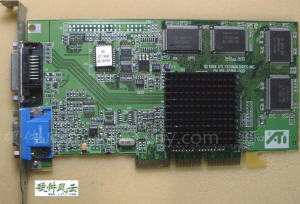
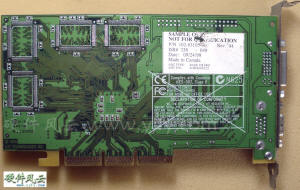
11.1.2.2 Qualification Sample
The sample sticker on the back of the graphics card is torn
off, only the sticker on the EEPROM remains, which is almost
the same as the official version.
PN 109-63100-00
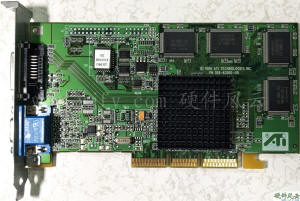
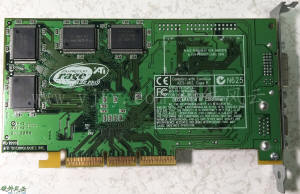
11.2 Xpert 2000 PRO
November 8, 1999 ATI Technologies Inc.announced the 32MB
Xpert 2000 PRO accelerator board for retail and PC OEM
markets, an add-in card that offers class-leading 2D and 3D
graphics and hardware DVD video Playback with 32MB of
memory.
The Xpert 2000 PRO is ideal for system builders and OEMs
looking to differentiate their lower cost PCs.
Traditionally, low cost PCs come with just 8 MB of graphics
memory, poor 2D and 3D and no DVD.
PN 109-65700-20
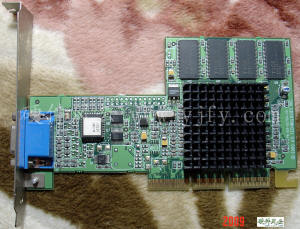
11.3 Rage Fury MAXX
October 7, 1999 ATI announces RAGE Fury MAXX , uses dual
RAGE 128 Pro Processors and 64 MB of memory to deliver 500
Megapixels/second of raw 3D performance for the Power Gamer.
Rage Fury MAXX is the legendary ATI "Aurora", and
essentially wants to learn the dual core of Voodoo5 5500.Due
to the lack of advanced features, Rage Fury MAXX is just a
bloated product that has not responded well to the market.
However, the highlight of the dual-core Rage Fury MAXX has
become the most nostalgic and most collectible ATI graphics
card.
11.3.1 Single head
11.3.1.1 Two EEPROM Engineering Sample
PN 109-67300-00A
|
12. Mobile series
ATI launched the Mobile series chips for notebook computers.
12.1 Rage LT
The PCI interface Rage LT chip similar to the Rage II, the earliest
was in mobile applications like notebook computers.Mobile chips
based on 3D Rage Pro chips have begun to be widely used.
November 11, 1996 ATI Technologies Inc.announced the industry's
first LCD accelerator to integrate high performance 3D rendering,
leading 2D performance, TV-quality video Playback, true color DAC
and LVDS transmitters, on a single-chip. The 3D RAGE LT will provide
users of laptops, as well as emerging applications such as desktop
flat panel monitors and LCD panel projectors, with a full range of
features and levels of performance previously achievable only on
desktop computers.
12.2 3D RAGE LT PRO
November 10, 1997.ATI announces the 3D RAGE LT PRO.
The 3D RAGE LT PRO, based on ATI's new market leader 3D RAGE PRO
accelerator, has the fastest 2D and 3D performance in the mobile
market.
First mobile AGP 3D notebook chip
First with Tri-View™ (for simultaneous disPlay on LCD, CRT, TV)
First with hardware acceleration for software DVD
First with 65 MHz integrated LVDS transmitters-~Fastest 2D and 3D
performance for notebook market
Engineering Sample
PN 109-45400-00C
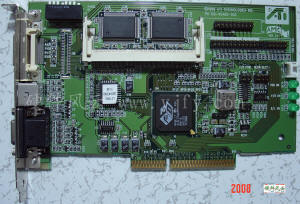
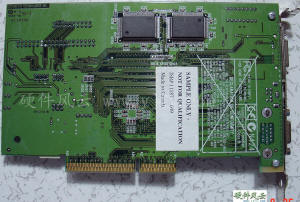
12.3 RAGE Mobility-M and RAGE Mobility-P
November 2, 1998
ATI Technologies Inc. announced its new RAGE Mobility family of
graphics accelerators, the RAGE Mobility-M and RAGE Mobility-P.
These new products enable a "one-component graphics sub-system
solution" and bring high-end performance in 2D, 3D and software DVD
to the mainstream notebook segments.
The RAGE Mobility family extends the capability of theRAGE LT PRO
graphics accelerator.
The RAGE Mobility-M and RAGE Mobility-P are pin-compatible with the
ATI RAGE LT PRO
12.4 RAGE Mobility-M1
February 22, 1999 ATI announces RAGE Mobility-M1 -- the world's
first notebook PC graphics accelerator with 8MB of integrated
memory.
RAGE Mobility-M1 is pin-compatible with RAGE Mobility-M and P and is
available in a similar package to RAGE Mobility-M, P and RAGE LT
PRO. With the addition of the RAGE Mobility-M1
12.5 Rage Mobility 128
October 25, 1999
ATI announces RAGE Mobility 128 - world's fastest single-chip
graphics subsystem for notebook PCs
Brings 128-bit desktop graphics to mobile computing for the first
time
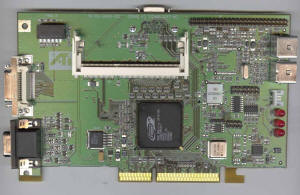
(From anandtech.com)
12.6 Rage Mobility M4
October 30, 2000 ATI Technologies Inc.announced Mobility M4, the
industry's first shipping AGP 4X graphics component for the mobile
platform. |
|
|
|